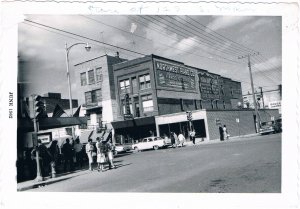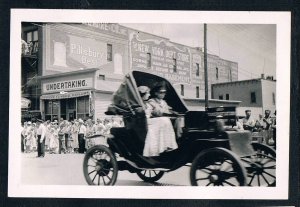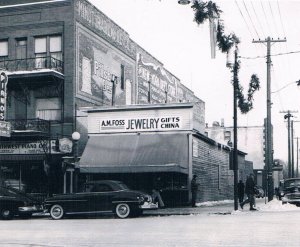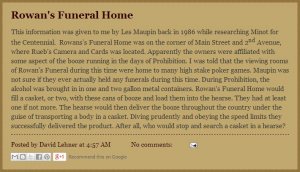azdiane
Member
I posted this earlier in a thread about naming out railroads, but I think our richly imagined histories deserve their own thread. This entry is about my Northland. Please join me and post the history of your railroad here. 
The Northland In the early years of the 21[SUP]st[/SUP] century, the Arizona Northland and Pacific Railroad, Inc. exists physically only as a free-lance model railroad, somewhere in-between the still-planning and the early-construction phase. But beyond physically, this railroad has a rich identity, a history, and a corporate ethos that live only in imagination. This is an invitation for you to share that imagination. Today's Northland railroad is set in yesterday; in the only vaguely defined "middle of the twentieth century." Actually, by just changing the types of trains and the styles of motor vehicles in the scene, the scene can be set to nearly any decade of choosing. But the baseline is the middle of the nineteen fifties: rock 'n roll is new, girls actually wear poodle skirts, milk is still delivered in cold glass bottles, and the Northland railroad is in its prime. In order to understand the railroad in the fifties, lets take a quick look at its long and rich history. Nearly a century earlier, just a couple of years before the American Civil War, savvy investors in the Arizona territory saw the opportunity that the likely-to-come war would bring, and the Northland railroad came into being. The first rail was laid by Irish immigrant laborers on October 12, 1857. From the beginning the railroad has been prominently known not by its formal name or by its initials AN&P, but as just the "Northland." The Northland’s directors had high-ranking associates in the United States Army, some of whom were themselves investors, and thus as war clouds gathered the Northland enjoyed early Union Army military contracts in the remote and sparsely populated District of the West. They invested those profits back into the railroad’s growth, and grew flush in those years of civil war and tragedy for America. During the post-Civil War reconstruction era, Northland management gained for the company well laid out rights-of-way across the vast rugged country of the American west, including through some spectacular mountainous terrain. They also secured very valuable traffic exchange rights with the Santa Fe, Southern Pacific, Denver Rio Grande and Western, and Union Pacific railroads, and gained a controlling interest in a far-away Pennsylvania coal mine. In the last decades of the 19[SUP]th[/SUP] century, continuing to be fed by contracts with an Army now battling the Indians, this small financially stable Northland thrived. Rather than growing lengthwise, Northland steadily grew more and more branches of track within its own territory, serving more and more existing little communities and providing a network of steel highways to foster new towns where none had been. The coming of the 20[SUP]th[/SUP] century brought continued growth. During the Great War of 1914-1918, the company not only did very well for itself by rediscovering its lucrative roots with Army contracts, it then roared through the twenties well capitalized, conservatively constrained in growth, and virtually debt free. Because of that, the railroad survived the desperation of the thirties better than many. In those awful depression times Northland management often ran a couple of empty boxcars on a train for those who couldn't travel otherwise. Now, at mid-century, the upstanding citizens of more than one of the small towns along the right-of-way can remember having been freezing kids standing in the snow back in those days, and the Northland train crews throwing them down big shiny black lumps of fine anthracite coal from the locomotive tenders that they could take home to grateful parents. As all times do, these times too, terrible as they were, did pass. Now the Second World War has come and gone. Germany, Italy, and Japan are our friends again. The savage war in Korea, virtually unnoticed by so many Americans, has wound down. The mid-fifties have become a period of great prosperity in our nation. It is also the era when more than a century of American steam locomotive technology is beginning to pass away from our tracks. American railroads are modernizing, acquiring fleets of the much more economical to operate diesel-electric locomotives. For most of the decade of the fifties, both types of locomotives will be commonly seen on the nation’s tracks, alongside their respective support equipment and structures. For this reason, in retrospect these days will become known to historians as the “transition era.” Dwight Eisenhower is in the White House. America is in the mega-boom times of the middle of the post-war decade, and Northland is hardly missing the dwindling military contracts because of the thriving civilian freight and passenger demand, particularly suburb-to-city commuter operations. Northland in this time-frame remains a profitable Class II railroad, providing valuable and appreciated service to the people of the small towns and cities along its main and branch-line routes, as it has now for nearly a century. The US Interstate Highway System is only just being planned. The time will come when motor freight's impact on the shipping habits of the little industries along the Northland's route will cut into the railroad’s profitability. But those days are still nearly a decade away. Today pickles, paint, and plumbing supplies routinely arrive, not only into town but often directly to the local industry itself, in boxcars. Refrigerated cars bring in fresh food daily to the remotest little whistle-stop villages. Fresh milk from farms goes out to the city every morning. Fine Pennsylvania anthracite coal is profitably imported across the continent to heat homes and businesses along the Northland’s route. The products of nearly countless small industries are shipped out to the world in Northland rail cars. Railway Express is the FedEx of its day. For most of the rural American west, the rails remain the primary link to the world. Most Americans in the mid nineteen fifties are still in the habit of travel by passenger train, as had been their fathers and grandfathers. For all that airlines are indeed beginning to thrive, train travel is still much cheaper and more familiar. In bedroom communities along the Northland's many branch lines, a stay-at-home-Mom can keep the family car all day if she drops Dad off at the train station. He can commute to his office in the city faster by train than he could possibly drive there in this nineteen-fifties world that has few freeways. Like so many other railroads in the country, even in these mid-century bright economic times the Northland railroad is dealing with capital challenges. Nice new diesel locomotives, while far more economical to operate and maintain than the older steamers, are expensive to purchase. Diesel fuel is cheap, and new diesel locomotives certainly will more than pay for themselves across years of time, but Northland management is conservatively unwilling to deplete its capital reserves. Northland has purchased only a few diesels, which it has been able to finance at good rates through local banks, and they operate mostly on the main lines. Older but well maintained steam locomotives continue to soldier on up and down Northland's branch lines, not yet beyond keeping in good repair by the railroad's in-house maintenance facilities. They are fueled with fine Pennsylvania anthracite hard coal, imported from the railroad’s own mine under the interline deals cut with eastern railroads two generations ago. Northland has a long-term funding plan for steam’s eventual replacement, but that time is yet to come. Some of Northland's smaller steam locomotives are in fact over fifty years old now, in the 1950's, yet are still in daily service. The passenger cars on Northland’s commuter trains are mostly the older heavyweight style, but are kept reasonably clean and well maintained. Safety, as a matter of current management philosophy and long-standing corporate ethos, is never compromised for profit by the Northland. But 1950's railroad practices, especially as regard public access to dangerous operations, including the tracks themselves, simply are far less stringent than might be considered the norm in the early 21[SUP]st[/SUP] century. Structures seen along the Northland's right of way often date back into the mid-to-late 1800's. As towns have grown up outward from the railroad, many of the older structures close to the tracks have fallen into decline. It's a reality that despite the value it brings, coal-fired steam-powered railroading is a dirty and sooty business for the whole neighborhood. Still, most of the old structures are alive and well in the mid-fifties, teeming with the lives of people who depend on the Northland to provide both the essentials and the frills of their daily lives. The Northland railroad is a way of traveling in time back to an era we like to think of as having been a simpler time. Whether it really was or not makes a great debate, but there is no debate that to the people of middle America in mid-century, the railroad is still a welcome how-could-we-live-without-it part of everyday life. Welcome to Northland's world. |
Last edited by a moderator:





